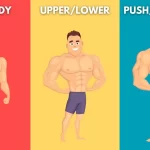Ever wondered why some muscles seem harder to grow than others? You’re not alone. The difficulty in muscle growth isn’t a one-size-fits-all situation. It’s a unique journey that varies from person to person, often leaving fitness enthusiasts puzzled and frustrated.
The ‘hardest muscle to grow’ isn’t set in stone. It could be calves for one person and abs for another. It’s all about knowing the reasons why a muscle isn’t growing, rather than ranking muscles on their difficulty in developing. So, let’s find out the challenges, and discover how to overcome them.
What Is The Hardest Muscles to Grow?
The difficulty in growing muscle can vary significantly from person to person due to factors like genetics, training intensity, nutrition, and rest. However, certain muscle groups are universally recognized as challenging to develop for many people. Here are some of the muscles that are often considered the hardest to grow:
1. Calves:
The calf muscles are notorious for being stubborn in growth. This is partly due to their daily use in walking, which means they have a higher endurance and may require more stimulus to grow. Additionally, genetics play a significant role in calf size and shape.
2. Forearms:
Like calves, forearms are involved in many daily activities and thus have a high endurance. Growing them requires targeted exercises, and even then, genetics will significantly influence their size.
3. Abs:

While most people have abdominal muscles, making them visible and developed is challenging. It requires a combination of low body fat and dedicated core strengthening exercises. The visibility of abs is also highly dependent on diet and overall body fat percentage.
4. Lower Back:
The lower back is a complex area that requires careful training. Developing this area can be challenging due to the risk of injury if exercises are performed incorrectly. Additionally, lower back strength is crucial for a variety of exercises and overall posture.
5. Hamstrings:
Hamstrings, the muscles at the back of the thigh, can be tough to develop due to their role in leg movements and the dominance of quadriceps in many people’s leg workouts. Balanced training that specifically targets the hamstrings is essential for their development.
Factors Affecting Muscle Growth Difficulty
Here are some factors that affect the muscle growth difficulty:

- Genetics: Your genetic predisposition plays a significant role. Some people naturally have a higher percentage of fast-twitch muscle fibers, which respond better to strength training and lead to quicker growth. Others have a dominance of slow-twitch fibers, better suited for endurance activities and less prone to hypertrophy (muscle growth).
- Muscle Activation and Mind-Muscle Connection: Effectively targeting a specific muscle during exercise is crucial for growth. This requires proper exercise form, knowing which muscles each exercise works, and developing a mind-muscle connection – the ability to feel the targeted muscle working during the movement.
- Training Intensity and Volume: Challenging your muscles with progressive overload (gradually increasing weight, sets, or reps) is essential for growth. Muscles that require complex movements or multiple muscle groups working together might necessitate a different training approach compared to isolated exercises.
- Recovery: Adequate rest and recovery are vital for muscle repair and growth. This includes proper sleep, a balanced diet, and allowing sufficient recovery time between workouts for targeted muscle groups.
Training Tips for Hardest Muscles:
Training stubborn muscles requires a strategic approach that focuses on intensity, volume, and recovery. Here are some tips to help you effectively train the hardest-to-grow muscles:

1. Increase Training Frequency:
Stubborn muscles often benefit from increased frequency. Instead of training them once a week, consider targeting them two to three times a week. This allows for more growth stimulus over time.
2. Prioritize in Your Workout:
Start your workouts with the stubborn muscle groups when you’re freshest and have the most energy. This ensures you can put maximum effort into training those muscles.
3. Use Compound and Isolation Movements:
Combine compound movements, which recruit multiple muscle groups, with isolation exercises that target the stubborn area directly. For example, incorporate deadlifts for lower back growth and hamstring curls for direct hamstring work.
4. Vary Your Rep Range and Volume:
Don’t stick to one rep range. Instead, vary your training by incorporating high reps with lighter weights and low reps with heavier weights. This approach targets different muscle fibers and stimulates growth.
5. Emphasize the Eccentric Phase:
Focus on the eccentric (lowering) phase of your lifts. This part of the exercise is crucial for muscle growth, especially in stubborn areas. Aim for a slow and controlled descent in movements.
6. Mind-Muscle Connection:
Actively think about the muscle you’re working on during each exercise. This focus can enhance muscle activation and lead to better growth over time.
7. Optimize Nutrition and Recovery:
Nutrition and recovery are just as important as your training regimen. Ensure you’re consuming enough protein to support muscle repair and growth and give your body ample rest between training sessions to recover.
8. Consider Drop Sets and Supersets:
Implement drop sets (gradually reducing the weight and continuing the set to failure) and supersets (pairing two exercises back-to-back with no rest) to fatigue the muscles thoroughly and encourage growth.
9. Stay Consistent and Patient:
Growth in stubborn muscles won’t happen overnight. Consistency in your training, nutrition, and recovery strategies over time is key to seeing progress.
10. Seek Professional Guidance:
If you’re struggling to see growth despite your best efforts, consider consulting with a personal trainer. They can offer personalized advice and adjustments to your training regimen.
Frequently Asked Questions
What is the most underworked muscle?
The most neglected muscle group, often underworked, is the Glutes. As one of the most important muscle groups for proper biomechanics and optimal sports performance, their condition significantly affects your bodily functionalities. In fact, weak Glutes muscles can even lead to back pain and injury due to their connection to the spine.
What is hardest muscle to build?
Calves usually pose the most significant challenge when it comes to building muscle mass. The anatomical configuration of the calf muscles resists hypertrophy, making their growth and development notably tougher compared to other muscle sets.
What muscles don’t stop growing?
A mutation in the gene encoding myostatin can cause muscles to grow unhindered by the standard cap on muscle size seen in almost all other mammals. Therefore, theoretically, these muscles don’t stop growing, but they won’t expand indefinitely throughout your life.
Which muscle takes the shortest to recover?
The fastest recovering muscles from an exercise session are typically the forearms, calf muscles, and abdominals. These muscles are in constant use in a reasonably active person. Overloading them without isolation can be quite challenging.
The post What Is The Hardest Muscles to Grow? appeared first on Ninja Quest Fitness.
Recent Posts
- #897 A Sneak Peak of the Love-Paced Race: Phylicia Masonheimer, Nicole Unice, and Nika Maples Share on What the Church Has Taught About the Body
- Bella Hadid Weight Loss: Tips From The Supermodel
- Introduction to the Z-Press
- How To Teach Yourself Transcendental Meditation?
- How Oxygen Therapy Can Enhance Your Respiratory Function




